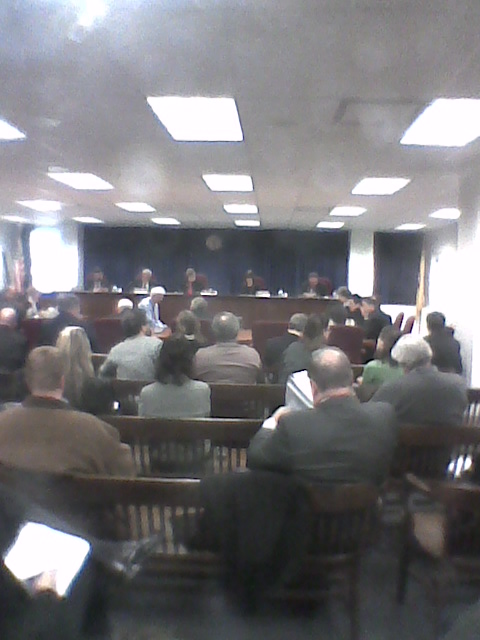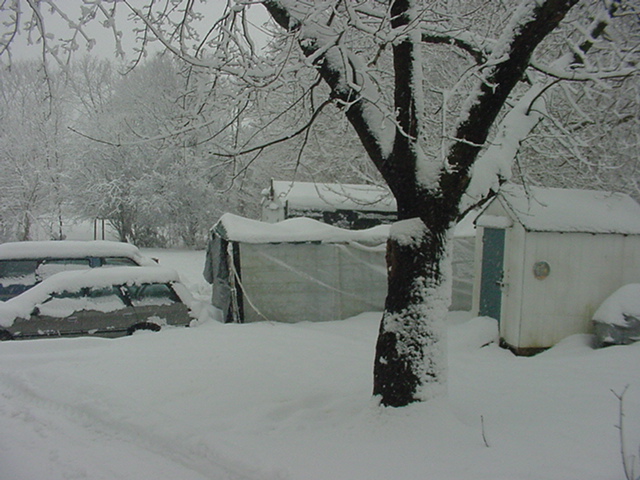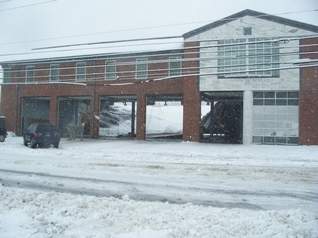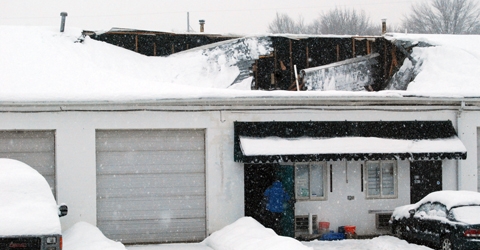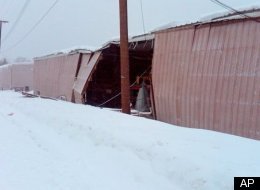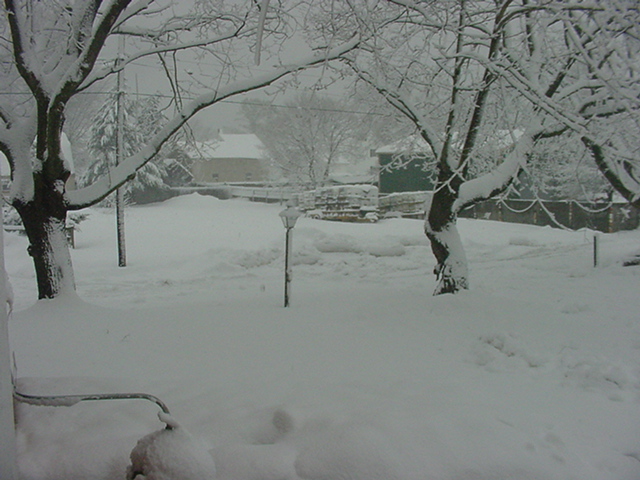STL in the news!
June 12th, 2010
Stop The Lines! has appealed the New Jersey Board of Public Utilities’ determination on the Susquehanna-Roseland transmission line, I’ve been representing them in this fracas, and from the news reports below, it looks like we’ve hit all the bases!
The Susquehanna-Roseland transmission line is absurd — they’re tearing down an existing low capacity line and putting up towers twice as high with … well… imagine this, QUAD bundled 500 kV line. Really… that is what they applied for, but midway through the hearing, they admitted that the structures couldn’t handle that and reduced it to TRI-bundled 500kV. ACSR at that, could it be more primitive? It’s absurd, if they 190 foot towers fell, with a 75 foot Right of Way, that’s 115 feet that it could extend beyond the Right of Way. It’s beyond absurd — it’s insane, and earth to mars, there are people right there, RIGHT THERE, don’t they care?
Plus it’s not needed, the Marketing Analytics report says it all:
Here’s the BPU order that we’ve challenged:
This is from the Pocono Record — be sure to click on the linkedarticle below to get to the Pocono Record comment section:
Power line fight heads to NJ court
For the Pocono Record
June 11, 2010New Jersey activists fighting proposed increases in the voltage and tower height of the Roseland-to-Susquehanna power lines are taking their battle to appeals court.
Four environmental groups and one onf the two private organizations made up of concerned homeowners filed court papers this week against the state’s Board of Public Utilities and utility company PSE&G. The papers charge that BPU, which approved the plan unanimously without comment in February, did not exercise due diligence in properly reviewing the proposal.
Stop the Lines, based in Fredon, N.J., has filed suit. It is one of two active private organizaitions in New Jersey opposing the project, along with the recently established Save the Park group in Hardwick Township, N.J., which has a sign advertising its cause on Hollow Road in Smithfield Township.
The suit contends the review lacked a proper analysis of the need for the project, failed to consider the environmental impacts of construction or weigh the secondary impacts of importing coal energy from Pennsylvania.
The existing 47-mile link of the 145-mile route, which extends through the Delaware Water Gap National Recreation Area and specifically through Saw Creek Estates in Lehman Township, would add 500,000 kilovolts and raise towers to 195 feet. It is under the auspices of the PJM Interconnection, which includes PPL on the Pennsylvania side and PSE&G, which is looking to recoup $3 billion in costs stemming from the deregulation of the energy sector in New Jersey.
The project still awaits approval by the National Park Service. New Jersey Sen. Bob Menendez recently sent a letter to park Superintendent John Donahue asking him and the National Park Service to exercise due diligence in its decision, which is due in 2012.
PSE&G spokesman Karen Johnson defended BPU’s decision, saying PSE&G is aware of the appeal and believes there is “ample evidence” to support its decision.
And from the Daily Record:
Morris area citizens group sues over power line plan
BY COLLEEN O’DEA • STAFF WRITER • June 10, 2010The citizens group Stop The Lines has filed an appeal challenging the state Board of Public Utilities’ approval of Public Service Electric and Gas Co.’s transmission line expansion through Morris, Sussex and Warren counties.
Stop The Lines’ appeal of the BPU’s January decision permitting the upgrade on PSE&G’s Susquehanna-Roseland power line is the second filed in appellate court in the last week. Four environmental groups that like Stop The Lines also had intervened in the proceedings filed an appeal last Friday.
The Stop the Lines appeal will focus on the lack of need for the expanded transmission line, which would add 500-kilovolt lines to towers as high as 195 feet along the 47 miles in New Jersey. The group also faults the BPU’s refusal to consider information on a possible decreased demand, health and safety impacts on landowners, residents and the environment and economic impacts ranging from loss of property value and tax revenue to inability of homeowners to obtain mortgages.
“Building 195-foot high towers within a 150-foot wide right-of-way is simply unreasonable,” said David Slaperud, a Stop The Lines trustee.
“We believe the ample evidence in the case fully supports the BPU decision that this line is needed for reliability,” said PSE&G spokeswoman Karen Johnson.
PSE&G is awaiting final environmental permits to begin working on the eastern half of the $750 million project, from Hopatcong to Roseland. It hopes to begin work this summer. The western portion, from Hopatcong to the Delaware River, has to await the completion of a National Park Service review because the line runs through the Delaware Water Gap National Recreation Area. That is expected to take until 2012.
The project was challenged in the BPU by citizen and environmental groups, several municipalities and the Montville School District. Ratepayers would foot the bill.
The line crosses from Pennsylvania at the Delaware Water Gap and proceeds through Warren and Sussex Counties. More than half the line would traverse Morris County, through Jefferson, Rockaway Township, Kinnelon, Boonton Township, Montville, Parsippany and East Hanover before ending in Roseland.
And in the New Jersey Herald:
Activists appeal state’s power line approval
Stop the Lines, the activist group that has been the most vocal and omnipresent adversary to the PSE&G line since its proposal in 2008, is appealing the Board of Public Utilities approval issued in February.
The appeal focuses on the need of the 500kV line, running 146 miles from the Poconos across northwestern New Jersey and into the heart of the Garden State. They will also question the economic impacts to property owners and municipalities along the line — which will double the height and triple the power of the existing 1920s-era transmission towers.
“Building 195-foot-high towers within a 150-foot wide right-of-way is simply unreasonable,” said David Slaperud, a Stop the Lines Trustee.
Four state environmental groups also appealed the BPU decision by the June 7
deadline.PSE&G has maintained brownouts could roll down the line as early as 2012 if the upgrade is not complete. However, the National Park Service blessing to cross the Delaware Water Gap will not be available until that year — and PSE&G put off seeking final environmental permits for the 20-mile Sussex County stretch of the line last month.
Stop the Lines appeals BPU decision
June 8th, 2010
Stop the Lines has appealed the New Jersey Board of Public Utilities decision approving the Susquehanna-Roseland transmission line through northern New Jersey.
The New Jersey environmental coalition that intervened in this docket, represented by Eastern Environmental Law Center, has appealed too!
This is yet another case of utility wants but NO NEED, and now, they’re trying to build only the eastern section! Say what?!??!! That’s not what the BPU approved!
+++++++++++++++++++++
Stop The Lines appeals BPU decision on PSE&G Susquehanna-Roseland power line project
Stop The Lines, a grassroots opposition group, has filed an appeal in the Appellate Division of NJ Superior Court challenging the Board of Public Utilities (BPU) decision to allow Public Service Electric & Gas (PSE&G) to build a massive power line along an existing right-of-way that was not designed to accommodate a line of this magnitude.
“Building 195-foot high towers within a 150-foot wide right-of-way is simply unreasonable,” said David Slaperud, a Stop The Lines trustee. Slaperud said that the proposed line would negatively impact property values, and that a project of this size running through residential areas is detrimental to public health and safety. “The BPU has not adequately addressed these concerns.”
“BPU was asked several times during evidentiary hearings to look at the most recent energy demand data, and they failed to request the additional information,” continued Slaperud. “Instead, they relied solely the word of Mr. Steven Herling, Vice President of Planning, PJM Interconnection, LLC (PJM), who stated, ‘We will do the analysis, but we already know what the results will be,’ when questioned during hearings. No facts, just basically a plea to ‘Trust us.’”
Tom Hill, another trustee of Stop The Lines added, “How could the BPU take Mr. Herling at his word, rather than simply looking at the data that is currently available? Something just doesn’t seem right – while energy demand continues to drop, BPU is willing to take PJM at their word rather than requiring data to back that assumption up.”
Stop The Lines attorney Carol A. Overland strongly agrees. “This BPU decision comes at a time when any utility infrastructure is suspect. PJM’s demand has been steadily decreasing since 2006, and recently PSE&G proposed to build only a part of it. That alone shows we’re not going to be freezing in the dark, the lights won’t go out. Add PJM’s State of the Market Report and the increasingly delayed RTEP, it’s just not plausible that they need this line. What’s clear is they WANT it, but their business plan and PJM’s marketing plan are not sufficient reasons to put landowners and communities through this transmission hell.” Overland stated that the proposed new project is far beyond what a demand increase would require. “It’s transmission on steroids at a time when we are in conservation training. The Susquehanna-Roseland Project is going backwards down the wrong path.”
The Stop the Lines appeal will focus on the lack of need for this massively expanded transmission line, and the BPU’s refusal to consider new PJM information showing an decreased demand now or in the foreseeable future; the uncertainty of rate-recovery, which is currently at issue at FERC; health and safety impacts on landowners, residents and the environment; and economic impacts ranging from loss of property value and tax revenue to inability of homeowners to obtain mortgages.
Stop The Lines also fully supports the issues raised by the four Environmental Groups – Environment New Jersey, New Jersey Highlands Coalition, New Jersey Environmental Federation and the New Jersey Chapter of the Sierra Club – in their appeal of the BPU decision, and will work in collaboration with them throughout the appeal process.
PSEG withdraws part of application!
May 23rd, 2010
It was one of those weeks. First CapX 2020 provides official notice that the Brookings-Hampton transmission line is delayed. [Motion to Suspend Proceedings!]
Hot in the heels of CapX 2020’s notice of “delay” of the Brookings-Hampton transmission line, PSEG provides official notice that it is withdrawing their NJ DEP permit for the Susquehanna-Roseland transmission line:
Please take notice in accordance with N.J.A.C. 7:A12.6(f). Public Service Electric and Gas Company (PSE&G) is hereby amending the above-referenced permit applications submitted to the New Jersey Department of Environmental Protection (NJDEP). PSE&G is withdrawing the applications for the section of the Project located to the west of the proposed Hopatcong Switching Station. The municipalities west of the Hopatcong Switching Station include Sparta Township, Byram Township, Andover Township, the Town of Newton, Fredon Township, Stillwater Township and Hardwick Township The company may resubmit a new application or applications to NJDEP for the western section of the Project at a later date.
It’s all here in their Notice to affected towns:
And here’s the real deal:
The funniest part is this — AS IF!!!
We know that they’ve got a problem at the Delaware Water Gap… we know they’ve got a problem at the NJ DEP… Now I wonder… how much of the Pennsylvania part is withdrawn???
Just like the CapX 2020 transmission project, the Susquehanna-Roseland transmission project was approved as a whole, the studies used to justify it were on the project as a whole, the BPU decision approving the project was on the project as a whole… so what, now they can say they just don’t need that part??? I don’t think so…
Live from the BPU
February 11th, 2010
Susquehanna-Roseland… surprise, surprise, they just announced that they’re going to hold off until the end of the meeting, do everything else on a long agenda first… sigh…
Here we go ROUGH NOTES
(with a few parenthetical comments)
BPU Agenda Meeting 2/11/10
Ken Sheehan: PSEG application. Starts in PA, crossing to NJ at DWG, through 16 municipalities, following 230kV RoW. PSEG building in conjunction with PPL in PA. NJSA stt, taking it before the board, prove it is reasonably necessary (blah blah)
Three outstanding issues.
- Request for Oral Arguments – staff recommends denial. may be useful if parties have had opportunities to make arguments. Wouldn’t appreciable add to process.
- Request for Depositions – for 2 PSEG attorney re editing of PJM’s Herling’s letter. Herling admitted they had made changes, but didn’t remember, and Motion followed. Recommend denial of request. Review has been minor, per Herling’s statement, board does not need additional info.
- Request for Dismissal – Internvenors requested, also recommended it be denied.
Fiordaliso: Are we to move on all of these now?
Ken Sheehan: Move after all the discussion.
Damase Hebert: Background. Proposed line is about 145 miles long, 45 miles of it is in NJ, crosses over Delaware Water Gap, Picatinny Arsenal. 2 switching stations, pursuant to a deal, agreed to move the Jefferson station to Hopatcong. East Hanover, PSEG is willing to move to Roseland. Entire project will cost between $900 million and $1.2 billion. Interventions of Townships, Municipal Intervenors, Gerdau Ameristeel, Willow Lake Day Camp & Fredon Bd of Ed, Exelon, Stop the Lines, Environmental Intervenors. Participant status to National Park Service as requested. Fiordaliso appointed to preside over hearings. (Commission Fox gave someone a big grin at this point) Public hearings and many written comments. Fiordaliso conducted site visit, 3 locations. Fiordaliso also presided over hearings, main topics covered included need, routing, engineering and construction, and electromagnetic fields. 400 exhibits and over 1,000 pages of transcripts (BFD!). PSEG witnesses, 4 on need, 4 on routing, 3 on engineering and construction, and 2 on EMF. Muni Intervenors sponsored 1 on need, 1 on EMF, and STL on ability of homes to obtain FHA mortgages. Briefs, Muni Intervenors, Env Inervenors, Exelon, PSEG, Rate Counsel. Reply Briefs too. During December, delays in other PJM ordered PJM lines, PATH, and MAPP. Board requested Sec. send letter to PJM requesting more information,Herling response 1/21, reopened for a day of hearings.
Jerry May (?) to address need.
Jerry May: Relies on PJM analyses, that there will be violations of NERC by 2012. (background on NERC). PJM analyses through RTEP process also determined that S-R 500kV was the most appropriate remedy for the projected recommendations. Intervenors have questioned the bases for assumptions and recommendations, available capacity and load. PJM has estimated over 15 year planning horizon, 13 different bulk transmission lines are asspected to be overloaded in assumed single contingency events. In addition, 10 are assumed to be overloaded for two lines on a single structure. Further explanation of what violations mean. (he’s presuming it’s cumulative, but those subsequent iterations replaced the ones that no longer demonstrated need!) Overloading of lines due to single contingency events is NERC Category B, while double contingency events are Category C. A NERC category A evaluates with NO contingencies, and PJM found no violations of category A criteria. PJM tests for load deliverability and generator deliverability. Load deliverability addresses defined load levels and ability of xmsn to deliver adequat power. Generator evaluates ability of generation to be delivered to PJM system at peak load conditions. Normal Peak Day condition assumes tha based on historical data there’s a 50% chance of being warmer or cooler. Emergency assumes only a 10% chance that the weather will be any hotter on that day. NERC category B requires that the system be evaluated with one system out of service, purpose is to ensure that system continues to be reliabile with instantaneous outage. For Cagoegory B, assumes emergency peak load for area being tested, and normal for rest of system. For Category C, requires the system be stable and within system limits, under a variety of multiple system events, i.e., lost of one system element, adjustments, and loss of second element. Double circuit tower line contingency that are the source of the cateogyr C violations projected by PJM in this proceeding. For thistype, no system readjustments are permitted as both are removed from system at same time, using normal load, that these are rare and not necessarily tied to weather conditions. Category B violations, PJM projected that violations would occur on two bulk power lines by 2012, and another 3 over next three years. Over the entire forecast period, PJM estimates 13 lines would have violations of NERC Category B criteria. 12 fail load deliverability, and 1 fails generator deliverability. Category C, ___ violations, over entire forecast violations, 10 lines would violagte category C criteia. All of them ae due to failing the PJM generator deliverability test. The NERC violations reflect PJM’s 2009 retool analysis. Earlier studies dating back to 2007 resulted in different mix, but the conclusions from each was that NERC criteria would be violated by 2012 if NERC did not take steps.
In the past month, PATH and MAPP were either withdrawn or held in abeyance due to updated analyses that the project was not necessary in the time frame. The Board directed that an additional hearing be held to determine what impact the delay in these lines would have for need for S-R. During the hearing, Herling reconfirmed PJM’s view that the project would continue to b enecessary to avoid violating NERC criteria as early as 2012. … that taking into account RPM auction, would not materially alter the conclusion. (WITHOUT ANY CITES OR SUBSTANTIATION!)
While PJM considered xmsn based alternatives, it found that none were as robust or would provide the long term solution. PJM’s position with respect to alternatives, such as adding generation, DSM, heightened efficiency, was that it had no power to order added generation or DSM. PJM’s contention was that transmission was the only measure that it had authority over to correct the violations.
Intervenors argued that the analyses are flawed, designed with a preordained conclusion, were challenging load forecasts, DSM, energy efficiency, and challenges more generally in the conservative nature of the PJM analyses. As an alternative to outright rejection, some suggest PSEG should hold this petition in abeyance until next RTEP report is in. Herling would not commit as to when the next RTEP would be completed, suggesting that the typical time frame is in the fall. Intervenors point out that the latest Retool does not reflect RPM, where significant amounts of demand response capacity cleared, and which would be included as available capacity in the 2012 year, and would also be included in the next RTEP analysis.
Staff’s review of the record leads us to conclude that PJM’s process does not result in a preordained conclusion and produces results that are reasonable. Intervenors complained that the most recent load forecast is too high, given the load drop. There is a great deal of uncertainty about economic recovery, and staff does not believe that PJM’s load forecast is unreasonable. PJM’s load forecast which reflected events since the last quarter of 2008, predicted drop of 1.4%, and actual drop in 2009 was 1.9% (not addressing that peak was in 2006 and it’s been falling). While the forecast underestimated the severity of drop, it did reflect actual recent trend. Economic growth projections used by PJM are geared to metropolitan areas located within PJM territory, and cannot be directly compared with national projections. (and PJM historic actuals and PJM trends?) Staff agrees that the results of the May 2009 RPM auction should be included, but witness Herling explains why even incorporating these results would not alter conclusions. Intervenors have noted that the May RPM auction resulted in significant demand response in those areas impacted, however witness Herling pointed out that demand response could not resolve Category C violations. Demand response is not on call during normal periods and is not sufficient time frame to offset Category C violations. Herling points out that while there was a significant demand response, there was a marked decrease in generation availability in relevant load zones, and net increase was relatively small. (note they never deal in impacts of energy efficiency, which reduces peak overall?) In contrast, the increases in demand response capacity where PATH amd MAPP were planned were substantial, … those were violations that MAPP and PATH were designed to address.
Intervenors have argued that PJM has failed to consider additional demand response coming, pointing to the New Jersey Energy Master Plan, however the board’s main resonsibility is to assure safe and adequate supply of electricity. Staff does not believe that PJM excluded the Energy Master Plan from models and consideration. (EH?) Just as PJM models do not include demand response, it also does not include generation that may or may not occur (yes it does, as he testified in the initial hearing, with different weights put on generation with an ISA and not).
Staff concludes that PSEG has met its burden that S-R is needed to avoid violations of NERC standards as early as 2010. The number, nature and severity of the violations all bear this out (Say what? Decreasing number, decreasing severity, and change in nature in blatant attempt to find some sort of violation). Realistic variations in the various key inputs would, in staff’s opinion (training, experience, they’re NOT engineers!), still point to violations as early as 2012. The fact that the violations grow throughout the forecast period points to the need for a robust response (they start at miniscule amounts above 100%, so small that FERC asked about optimization).
Next issue is routing.
Damase Hebert: PSEG presented expert testimony that Route B was most appropriate route. Luis Berger retained to evaluate routes. Berger reviewed 3 alternative routes, selected Route B, which follows existing line. Impacts least area of forested land, impacts least amount of forested wetland, fewer streams crossed, no change in existing land use, crosses Appalachian Trail on existing 230kkV RoW, least distance of Highlands area crossed, all on existing cleared RoW, likely to have the least impact compared to the other alternatives routes because existing RoW would not have to be expand. Staff recommends approval, because it runs along existing RoW, least impact compared to other route. Minor adjustments may be appropriate. Montville has requested move 3 specific towers, and staff reocmmends that Board direct PSEG to relocate or report why it’s not pssible. In relation to routing issue, STL argued that existing residential homes within a specific distance no longer eligible for FHA. Baord staff recommends further evaluation of this issue. Switching issues, Jefferson and E hanover, and alternatives were proposed. Staff recommends moving substations. Staff notes that use of existing RoW reduces impacts, if approved by board, towers will either be monopole or towers based on characteristics of route. During course of proceeding, company changed from 4 to 3 conductors, impacts charactteristics of line, change is based on engineering requirements. Likely to reduce EMF fields. (EH?). Intervenors have not provided sufficient evidence to prove it’s not safe. Comapny argues EMF is not dangerous, and EMF are below limits established by any state and regularly used appliances. Staff has analyzed EMF testimony, and has comcluded that it will be below all established standards, and electrical fields will below NJ’s standards. Staff recommends that the board require PSEG monitor EMF levels and report results to board, to demonstrate that this meets their state EMF levels.
Cost allocation methodology. Current PJM tarrif regionalized it across PJM. FERC has adopted paper hearing, which has been set in response to the remand from 7th circuit decision directing FERC to explain why current methodology is sound (NO IT DOESN”T, that is NOT what remand said and it is not what FERC is requesting in its Order to PJM). It is unknown when the board will have complete certainty of cost allocation (short paper hearing process, it’s fast tracked). Given long construction schedule, staff recommends the board not wait until cost allocation (Fox is smiling again at this point)
Staff urges that board issue an order that local zoning does not apply. Board attach conditions:
– Board direct PSEG to work with Montville Bd of Ed to relocate towers to address their concerns.
– Company follow with report relocating 3 towers to relocate.
– Work in good faith to determine relocation of other alignments that are practicable
– Report within 90 days about other relocations, and if can’t, proceed as proposed.
– Continue to optimize locations of access roads, tower locations and structures, with other agencies to greatest extent possible.
– Evaluate issues explored about inability to obtain FHA mortgages.
– Monitor regarding EMF levels
– Work on continuing basis with fire and safety at Hopatcong and Roseland
– Avian protection plan with guidance from USFWS
– Board require the company to report to the Board the findings of PJM’s next RTEP analysis. If that RTEP analysis finds that the project is no logner necessary or can be delayed significantly, staff recommends the Board retainspecific authoirty to reopen the proceeding.
– Hopatcong and Roseland switching stations, should routing require modifications, get approval from board.
– This route is located with areas governed by the National Park Service, Highlands Preservation Act and the Watershed Property Review Board. Staff recommends that the board specifically state in its order that the order shall not be construed as certificate, license, permit to construct or disturb land in these jurisdictions until the company receives the relevant approval from these governing bodies and from any other non-municipal bodies.
Fiordaliso moved, ?? (male) seconded.
Fiordaliso – Having served as hearing officer, which has taken about a year to come to judgment, I feel confident that this board has fulfilled its duty to residents of state of NJ. Staff committed time and resources, investigating every possible angle, trying to determine whether this is needed, to maintaini electrical service, for all their hard work, I would like to point out certain individuals (thanks staff). Speed sometimes does not substitute for trying to get it right. I have to indicate that this was the most difficult decision that I’ve had to make since I’ve been a member of this board, to weigh all the factors involved during the evidentiary hearings. This was a fair and open process, everyone who wanted to participate could, I wanted them to walk out of the public hearing indicating that they could be heard. I have heard from the public and witnesses, met with staff, examined every angle of this proposal when PATH and MAPP revelation occurred. The only thing I could do was to take notice of that, and the supplemental hearing that we had htis month. With that, it is my contention that it hinges on reliability, increasing infrastructure is a reasonable plan, everyone wants to avoid power outages plaguing our already fragile system. This project is one part of a wider system, remain focused on renewable, but we have to ensure safe, reliable service for the state of NJ. PSEG will work with other stakeholders so the process will be a fair and equitable one for all parties.
Butler: I have nothing to add, I think staff’s analysis was thorough, I’m convinced this is needed.
Fox: Lot of questions and issues. First, I want to let you know, I reluctantly will be voting for this. I am hoping that we will not go through this again. This is an issue of timing, what’s in front of us now (they could choose to wait a couple weeks for additional information that’s in the works). NERC sets reliability standards, FERC picked NERC, this is based on need, balancing out reliability for the good citizens of this state. Based on what we have in the record. What is in the record says there is a need, in 2012. Timing is everything, PJM projected then, it projects that now, violations in 2012, that’s a little over 2 years away. It’ll take 18 months or so for this to be constructed. Our first responsibility is reasonableness of service. We are subject to a one year time constraint. If we don’t decide this, we are told this will go to FERC and they will take over the case. A lot has happened, an economic downturn has taken place, federal government is promoting appliance standards, GHG has not been passed but some day will have to be, NJ will establish more extensive programs to reduce electricity use, a large part revolves about how much it is reduced, we have clean energy, efficiency, renewable energy programs, most of that is not included by PJM. The Energy Master Plan has reduction of energy use, that is not factored in. FERC oversees PJM, this board does not. PJM is largest wholesale power in the world, responsible to NERC and to FERC, they do not report to us (sure, give away your authority over transmission, good idea). PJM’s RTEP, looks at transmission, generation, customer loads. The higher the forecast.. PJM’s RTEP, category A, B, C violations were possible, and I think that NERC set these standards and the RTO’s are responsible for following. Fine? (from staff: Fine of up to $1 million a day). Differences between MAPP and PATH, staff has asked for a briefing, two, and it comes down to category C violations, this is not responsive to demand response. Herling testified that project would still be needed, not directly impacted by load forecast, so we still have this violation, the loss of double circuit line. The issue I want to get to is risk. How much risk are we willing to bear, how much are we going to take, prevent that from happening. Herling had no knowledge of what that risk might be. Modeling, when I was at EPA we did a lot of modeling, and I am not happy with how this is being handled. TEAC is contemplateing using sensitivity analysis on load forecast, and the only information we have in the record is from PJM, taking into account different load forecast, using state’s projections, great idea, they don’t do that now. How much are we going to pay for not having an outage. Asked to look at actual peak loads in NJ, and it’s quite minimal. From 06-09, the unrestricted load has exceeded peak for 44 hours. What is the risk that we’re willing to pay for? We are used to having outages, when weather occurs, and I’m sure we could probably pay away, that’s a risk analysis that I’m sure had been done. Is the risk that we’re lessening here worth the cost of a billion dollar line balanced against cost and impacts. We need to get PJM to look at risk of outage, balanced against category C. NERC has been modified standards, but again, timing is the issue. NERC requires RTOs to test events, each has their own internal test, as NERC modifies, they should consider consistent standards, tests, for all future analyses. Federal Policy Act of s005, set up two NIETC, where here is a huge need, we’re smack in the middle of it, we’re paying more because we’re congested. The recommendations staff did I thought were good. I ask that my fellow commissioners to ask the RTO to develop some risk and cost benefit analysis if you don’t require it in their case, why would they), category C violations, having RTOs accountable. What PJM did was require a billion dollar transmission project. The existing record I don’t think clearly showed the impact of these violations, that our ratepayers are paying for (and you’ll approve it? HELLO!?). That needs to be done for any xmsn lines (like THIS one?). When the RTO says it exceeds rating, we need to look at the magnitude. Load forecasting needs to be modified in PJM, direct and indirect costs and benefits, i.e. EMF, does it fit here or not, I think that we really need to look at what raetpayers would pay. Board has been working on effective alternatives to xmsn, national and regional level. Our NJ Master Plan deals with that, and it is not in the RTEP model. No one seems to have jurisdiction over generation. (well duh, you deregulated!). New generation, existing generation, we don’t have control over instate generation, what goes out of service. We need most cost effective way to look at generation, it’s probably in Washington, maybe us working with other states. Due to timing of this issue, and what is in the record before us, there is not any real evidence looking at load forecasting, looking at forecasting, I’m obviously gong to have to vote for this (??? that conclusion makes NO sense) and obviously having reliability issues two years from that.
Nicholas Asselta: The reliability is what strikes me as the most important, infrastructure is what NJ is about today, and in the future, has to continue to move forward to make us economically viable. We know what our situation is, we know what the situation of the US is in the world competitive market, it is the key for us to retain power. I bleive this project is needed reliability wise, major imporovements, I support this project.
Elizabeth Randall: We all went to staff over and over. The need is critical, the category C violations are important, and it is unacceptable to do nothing, it is important to have reliability.
Fiordalis0: Forgot one of his extended family (moi) in the back.
Board: Unanimous vote.
(BARF – how disgusting can it get)
It’s snowing again… another TWO FEET!
February 10th, 2010
My world has turned black and white… here’s the view out the door, the tent for the airplane buckled this morning. We had to go out and get fuel oil for the boiler and gas for the tractor and the roads haven’t been plowed from last weekend’s storm, and here we are now smack dab in the midst of another. The governor has shut down the state, again… and meanwhile, tomorrow at 2 p.m. the New Jersey Board of Public Utilities is making its decision on the Susquehanna-Roseland, delayed from today because of the storm. Well, it’s gonna be storming all day, so I don’t think that this one day will make a difference, other than those of us coming from a distance will probably have a harder time because they’ll be another foot and a half of snow.
Our little tent roof wasn’t the only one collapsing. It could be a lot worse. Schools, big boxes all over Delaware, and even the Townsend Fire Company roofs have collapsed:
Fair Use from The News Journal/ESTEBAN PARRA
Houses too:
And then there’s the Smithsonian warehouse:
… and more view out the window back door — those crab pots aren’t going anywhere anytime soon. Just so that tree doesn’t come down on the van:




